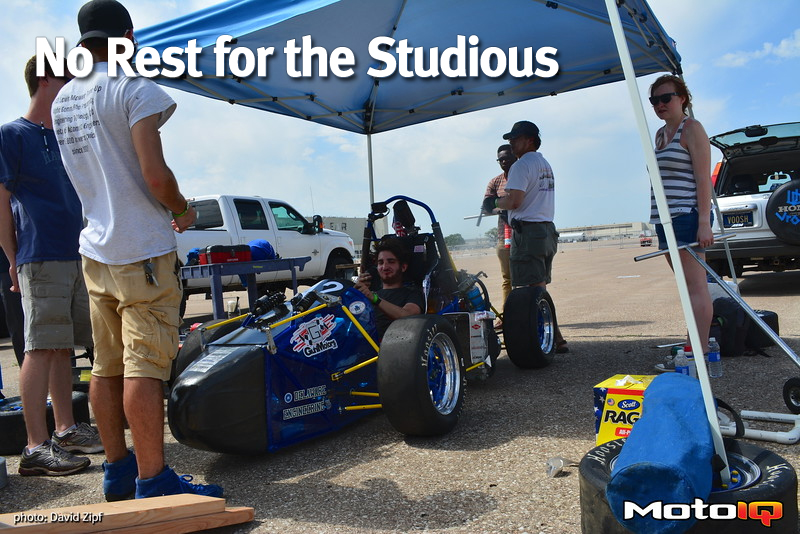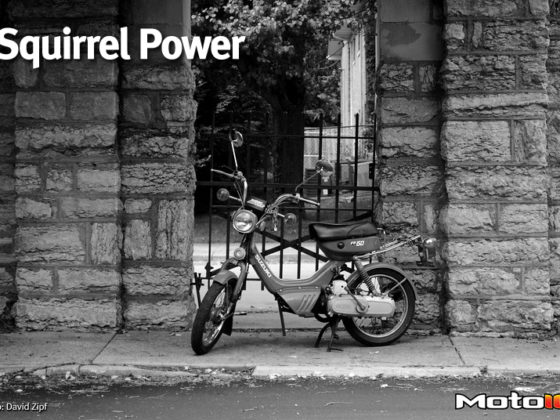,
 The lever on the far right is the shifter for the 6-speed sequential dog box. The linkage is rather cumbersome because the shift arm into the gearbox is on the left side of the engine. Why did we do this? Because our advisor mandated it. His exact wording was “My 8 year old son should be able to get in and drive this car.” Well between you and me, if someone can’t handle a sequential shifter on the wrong side of the race car then maybe they shouldn’t be in that race car in the first place! The shifter is hardly ever used and the linkages and bearings add a few unnecessary pounds. The L-shaped handle is there to satisfy SAE rules, namely that all driver controls must be within the cockpit. Because the cockpit is so narrow, there is no room to fit the shift linkage inside (it would fail the template tests), so the linkage is mounted outside the chassis and the L-handle gives us a legal place to grab it.
The lever on the far right is the shifter for the 6-speed sequential dog box. The linkage is rather cumbersome because the shift arm into the gearbox is on the left side of the engine. Why did we do this? Because our advisor mandated it. His exact wording was “My 8 year old son should be able to get in and drive this car.” Well between you and me, if someone can’t handle a sequential shifter on the wrong side of the race car then maybe they shouldn’t be in that race car in the first place! The shifter is hardly ever used and the linkages and bearings add a few unnecessary pounds. The L-shaped handle is there to satisfy SAE rules, namely that all driver controls must be within the cockpit. Because the cockpit is so narrow, there is no room to fit the shift linkage inside (it would fail the template tests), so the linkage is mounted outside the chassis and the L-handle gives us a legal place to grab it. The pedal box is made from simple 1” aluminum square tubing. The brake pedal is from Wilwood, complete with balance bar. It is hooked up to a pair of Wilwood master cylinders. Behind the brake pedal is an overthrow switch that kills the engine if the brakes fail. The clutch and throttle pedals are fabricated in-house. The whole apparatus is spaced up on some machined delrin blocks to let the master cylinders clear the floor tubes of the chassis. The whole thing can be unbolted and moved forwards or backwards to accommodate taller drivers, but we just set it in one place and left it because our 4 selected drivers were all nearly the same height. You may notice there are no fluid reservoirs: we determined that becaue the Wilwood PS-1 brake calipers use such thin brake pads, reservoirs were unnecessary! Intead, we used some clear PVC tubing with a PCV valve on the end to act as our reservoirs. The PCVs act as one-way valves to let air in, but not let fluid out. The hoses hold just enough fluid to account for brake pad wear and thermal expansion. Without the big reservoirs, this frees up some room for feet and saves about a pound in weight.
The pedal box is made from simple 1” aluminum square tubing. The brake pedal is from Wilwood, complete with balance bar. It is hooked up to a pair of Wilwood master cylinders. Behind the brake pedal is an overthrow switch that kills the engine if the brakes fail. The clutch and throttle pedals are fabricated in-house. The whole apparatus is spaced up on some machined delrin blocks to let the master cylinders clear the floor tubes of the chassis. The whole thing can be unbolted and moved forwards or backwards to accommodate taller drivers, but we just set it in one place and left it because our 4 selected drivers were all nearly the same height. You may notice there are no fluid reservoirs: we determined that becaue the Wilwood PS-1 brake calipers use such thin brake pads, reservoirs were unnecessary! Intead, we used some clear PVC tubing with a PCV valve on the end to act as our reservoirs. The PCVs act as one-way valves to let air in, but not let fluid out. The hoses hold just enough fluid to account for brake pad wear and thermal expansion. Without the big reservoirs, this frees up some room for feet and saves about a pound in weight. One of the few high tech additions to this car was AIM’s smarty cam. Not only does it record video like a GoPro, but it also has a GPS sensor in it to create an overlay for the track. Using AIM’s software, one can overlay video with telemetry data, aiding in driver training and suspension setup. We also borrowed GoPro cameras from our school’s library whenever we went driving. Having video to review, even without the fancy telemetry overlays, really helps isolate driver mistakes. It also allows you to watch parts of the car, like the suspension (or diff mounts), in action.
One of the few high tech additions to this car was AIM’s smarty cam. Not only does it record video like a GoPro, but it also has a GPS sensor in it to create an overlay for the track. Using AIM’s software, one can overlay video with telemetry data, aiding in driver training and suspension setup. We also borrowed GoPro cameras from our school’s library whenever we went driving. Having video to review, even without the fancy telemetry overlays, really helps isolate driver mistakes. It also allows you to watch parts of the car, like the suspension (or diff mounts), in action. No racecar is complete without bodywork. The floor, side panels, and firewall are all aluminum sheet metal. These have to be removable for servicing. The nose has to cover an impact structure made of closed cell foam. Here Rob is sanding down some glued together foam blocks leftover from our seat mold to make a mold for a carbon fiber nosecone. The foam was originally donated by DOW Chemical. I think this foam is used for insulation, but it is also ideal for making molds.
No racecar is complete without bodywork. The floor, side panels, and firewall are all aluminum sheet metal. These have to be removable for servicing. The nose has to cover an impact structure made of closed cell foam. Here Rob is sanding down some glued together foam blocks leftover from our seat mold to make a mold for a carbon fiber nosecone. The foam was originally donated by DOW Chemical. I think this foam is used for insulation, but it is also ideal for making molds. Next, Chris and Rob smother the foam in body filler so they can sand it smooth and give a good finish that the resin will not adhere to. We drafted up a rough design in CAD to ensure the nose would clear the impact structure and meet SAE’s rules. We also did a basic CFD simulation on it because doing CFD on the nose counts as aerodynamics work and gives us a couple points for aero design. Every point counts and 1 point is better than 0.
Next, Chris and Rob smother the foam in body filler so they can sand it smooth and give a good finish that the resin will not adhere to. We drafted up a rough design in CAD to ensure the nose would clear the impact structure and meet SAE’s rules. We also did a basic CFD simulation on it because doing CFD on the nose counts as aerodynamics work and gives us a couple points for aero design. Every point counts and 1 point is better than 0.


